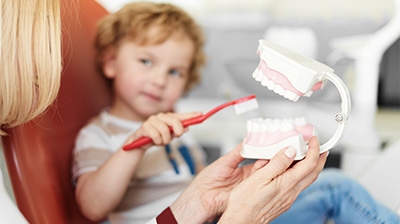
Top Pulpotomy Services in New York
Reliable Solutions for Tooth Decay in Children
To help preserve teeth that have been severely damaged by tooth decay, our pediatric dentists may recommend a therapeutic pulpotomy treatment in New York. This therapy allows Dr. Robert N. Goldsmith and Dr. Jessica Lynch to isolate and treat infection or damage to the inside of the tooth.
To learn if your child needs a pulpotomy in New York, call (844) 910-3557 or fill out our contact form to speak with our West Side Kids Dental team.
Understanding Pulpotomy: What It Involves
Pulpotomy is an endodontic treatment that is most often used on primary (baby) teeth. When decay or injury reaches the dental pulp, which is the innermost layer of the tooth, you often experience tooth pain and sensitivity. If not treated, the tooth will likely abscess and eventually require further treatment or extraction. In order to prevent this, our pediatric dentists may recommend pulpotomy treatment.
Steps Involved in Pulpotomy Treatment
During pulpotomy treatment, we remove the decay and the pulp chamber. The area is sterilized, but unlike a regular root canal treatment, the tooth nerves are not removed or treated. In some cases, not all of the dental pulp is removed, maintaining the vitality of the remaining healthy pulp. For these situations, we often use a therapeutic dressing to maintain the healthy pulp. After the decayed pulp is removed and the tooth is cleaned, the tooth often requires a dental crown. We most often recommend stainless steel crowns for children.
While pulpotomy is rarely recommended for permanent (adult) teeth, this treatment may be suggested if decay has reached the pulp but much of the pulp is still healthy. If the roots of the tooth have not finished forming, a partial pulpotomy can give the tooth a chance to finish forming.
Recognizing When Your Child Needs Pulpotomy Treatment in New York
Pulpotomy treatment, often referred to as a "baby root canal," may be necessary for children experiencing specific dental issues. Signs that your child may benefit from a pulpotomy include:
- Persistent Toothache: Complaints of persistent tooth pain or discomfort may indicate pulp inflammation.
- Visible Tooth Decay: Visible signs of tooth decay, such as cavities or discoloration, can suggest pulp involvement.
- Sensitivity to Hot or Cold: Heightened sensitivity to hot or cold foods and beverages may be indicative of pulpitis.
- Swelling or Redness: Swelling or redness around the affected tooth may signal an infection in the pulp.
- Difficulty Sleeping: Discomfort that disrupts sleep patterns could be a sign of underlying dental issues.
- Refusal to Chew on One Side: If your child avoids chewing on one side of their mouth, it may be due to dental pain.
- Bad Breath: Persistent bad breath not attributed to other factors might be associated with pulp problems.
- Pain During Brushing: Complaints of pain or discomfort while brushing the affected tooth.
If your child exhibits any of these signs, consult our New York pediatric dentist promptly. Early detection and intervention with a pulpotomy can often preserve the tooth and prevent further complications. Regular dental check-ups also aid in identifying potential issues before they become more severe.
Post-Pulpotomy Care: What to Expect
Due to the nature of the procedure, it's not uncommon for your child to experience some minor pain, swelling, and discomfort. This can be managed by applying a cold compress to the area as well as by administering child-safe over-the-counter pain relievers. However, if your child is still experiencing discomfort, pain, and swelling for more than a few days after the treatment, give us a call.
Commonly Asked Questions About Pulpotomy Treatment
Will the pulpotomy affect the permanent tooth that will eventually come in underneath the baby tooth?
Generally, a properly performed and successful pulpotomy on a primary tooth does not negatively affect the developing permanent tooth underneath. The treatment focuses on the crown of the baby tooth and the healthy pulp in its roots. The permanent tooth develops in a separate tooth bud below the primary tooth's roots. However, if the infection in the primary tooth is very severe and left untreated for a long time, it could potentially affect the underlying permanent tooth bud in rare cases. This is another reason why timely treatment like a pulpotomy is important. We closely monitor the health of your child's primary teeth and the development of their permanent teeth during regular check-ups.
How long is a pulpotomy expected to last? Will the baby tooth still fall out naturally?
The goal of a pulpotomy is to keep the primary tooth healthy and functional until it naturally exfoliates (falls out) to make way for the permanent tooth. With proper care and regular dental check-ups, a pulpotomized tooth can last for several years, typically until its natural shedding time. The lifespan of the treated tooth depends on factors such as the extent of the initial decay, the type of restoration placed, and your child's oral hygiene habits. We will monitor the tooth at each check-up to ensure it remains healthy and is on track to fall out naturally.
Further To Explore: Additional Reading on Pulpotomy
For more information about pulpotomy in New York and the other high-quality services we provide, please feel free to contact our office — send us a message or call (844) 910-3557 today.




